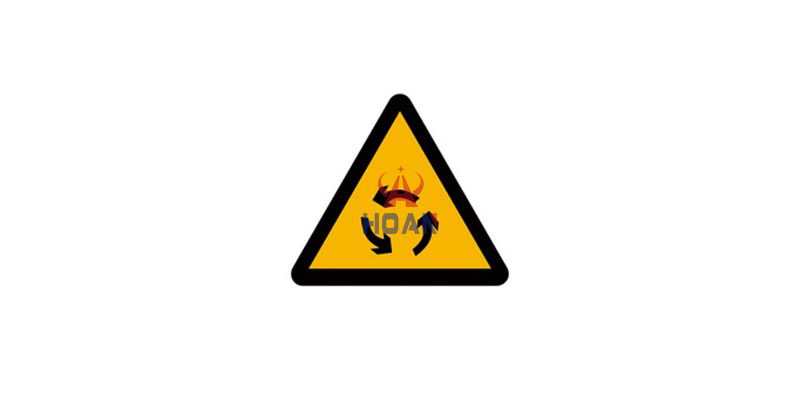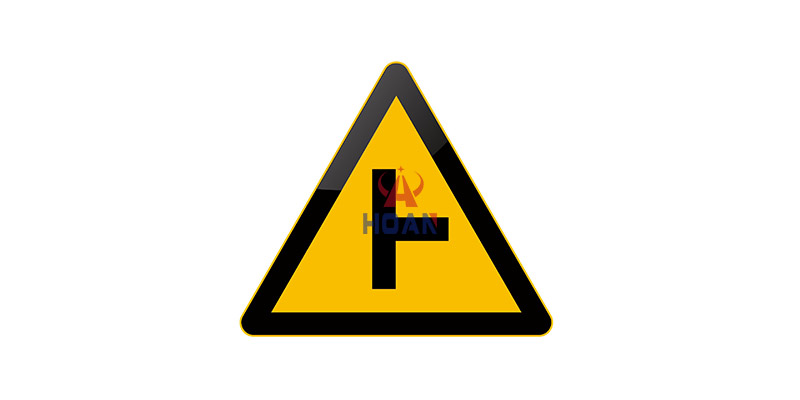Traffic warning signs are traffic signs that use specific patterns, colours, and shapes to alert road users in advance of potential hazards, changes in road conditions, or special circumstances on the road.
Within the traffic sign system, they are an important component that helps road users prepare in advance, avoid risks, and enhance travel safety.
In terms of shape, traffic warning signs are typically equilateral triangles with the apex pointing upward. This shape has a strong visual warning effect, quickly capturing the attention of road users.
In terms of colour, they are usually yellow with black borders and black patterns. Yellow symbolises warning, while the black patterns and borders make the sign content clearer and easier to read, even from a distance.
Traffic warning signs are generally placed at a certain distance from hazardous points or road condition change points. This ensures that road users have sufficient reaction time, such as before sharp bends, intersections, or near schools, where they can see the corresponding warning signs in advance.

Sharp bend warning signs are common, such as left sharp bends, right sharp bends, and consecutive bends. Their purpose is to alert drivers to the high curvature of the road ahead, requiring them to slow down, drive cautiously, and prevent accidents caused by sharp turns.
Hill warning signs include uphill steep slopes and downhill steep slopes. These signs remind drivers to control their speed and gear according to the slope's gradient, avoiding insufficient power on uphill sections or loss of control due to overheated brakes on downhill sections.
Road condition warning signs include slippery road surface, icy road surface, and uneven road surface. These signs inform drivers that the road conditions ahead are poor, requiring them to reduce speed, maintain a safe following distance, and prevent accidents caused by skidding or bumpy driving.
Intersection warning signs cover cross intersections, T-shaped intersections, Y-shaped intersections, etc. When encountering these signs, drivers should be mindful of oncoming vehicles, slow down and observe before proceeding to avoid collisions at intersections.
Merge and Divide Warning Signs indicate that vehicles are merging or dividing ahead. At this point, drivers should maintain a safe distance from other vehicles, drive cautiously, and avoid accidents such as scrapes.
Pedestrian and child warning signs are commonly found in areas with high pedestrian traffic, such as schools and residential areas. They remind drivers to be vigilant, slow down, yield to pedestrians, and pay particular attention to the movements of children.
Wildlife warning signs are installed on roads in suburban and mountainous areas where wildlife is present. They alert drivers to carefully observe the road surface and surroundings to avoid collisions with suddenly appearing wildlife.
Construction zone warning signs, such as ‘Construction Ahead’ or ‘Road Closed,’ inform drivers that there are construction activities ahead and that they should follow the instructions to detour or slow down to ensure the safety of the construction area and themselves.
Railway crossing warning signs indicate that there is a railway crossing ahead. Drivers should slow down in advance, confirm that no trains are passing, and then safely cross to avoid collisions with trains.

Traffic warning signs enable road users to be aware of potential risks before reaching hazardous areas, providing sufficient time to take measures such as slowing down or avoiding obstacles. This reduces the likelihood of accidents from the source, establishing the first line of defence for road safety.
Through clear warning information, traffic warning signs guide drivers to operate in accordance with safety standards. Drivers adjust their driving behaviour based on the signs, avoiding traffic chaos caused by reckless driving and ensuring smoother traffic flow.
Warning signs targeting vulnerable groups such as pedestrians and children prompt drivers to pay closer attention to their surroundings. In these areas, drivers instinctively slow down and remain vigilant, providing additional safety protection for vulnerable road users.
Road users should actively learn and memorise the patterns and meanings of various traffic warning signs. Only by being familiar with these signs can one quickly understand the information they convey and respond appropriately when encountering them.
Do not take chances when you see a warning sign. Regardless of how the road conditions appear at the time, strictly follow the prompts to take corresponding measures. Do not speed, cut in front of others, or act carelessly, as this may lead to danger.
Road conditions may change over time, and warning signs may be adjusted accordingly. Road users should be mindful of newly installed or modified signs and adapt to these changes promptly to ensure their driving complies with current road requirements.
In summary, traffic warning signs act as the ‘early warning system’ on the road, providing clear warning information to ensure the safety of all road users.
We hope everyone will take traffic warning signs seriously and comply with them, working together to create a safe and orderly traffic environment so that every journey can be safe and smooth.